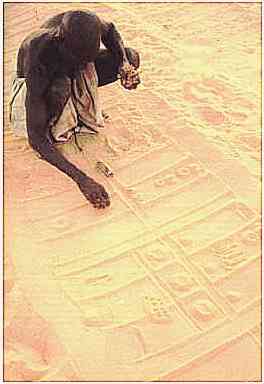| image |
caption |
 |
a
typical Manjak shrine, adjacent to a fromager tree; both
are housing a land spirit (Manjak: ucaay;
Kriolo: irań) |
 |
a
typical set of ancestral poles (Manjak, singular: pechįp) |
 |
containers
for sacrificial rum (canna)
in front of a diviner-priest's (Manjak: napene;
Kriolo: jambakosh
-- the latter word is written on the door) shrine,
exemplifying local obsession with containers of fluids as
models of the human body, the world, and sacrificial
relations |
 |
a
returning labour migrant drinks the remainder of the
sacrificial rum (canna)
after pouring a libation for his ancestral shrines; note
the jeans jacket over the locally woven and tie-dyed
wrapper |
 |
however
inconspicuous, the pole in the foreground marks the
principal land shrine owned by the major land priest of
the Calequisse area, Antonio Ampa, the aged king (Manjak:
nasīn) of the
grave-diggers' guild, which is the association of the
area's highest-ranking ritual specialists |
 |
a
senior member of the grave-diggers' guild sweeps the area
around the guild's shrine immediately before the guild's
annual sacrifice |
 |
at
some distance from the grave-diggers' guild's shrine
where the male members have their annual sacrifial
ritual, their wives prepare a meal from the meat yielded
by the sacrifice |
 |
the
members of the grave-diggers' guild share a ritual meal
of the pigs they have sacrificed earlier in the course of
the annual ritual at their guild's shrine |
 |
a
local administrative king (Manjak nasīn,
Portuguese/Kriolo: regulo)
at the varanda of his house, looking at his ancestral
shrine; note the sacred fromager tree in the background
it
is this shrine which features as vignette in the headings
of the pages of this website |
 |
children
at dusk against a background of the king's ancestral
shrines |
 |
pouring
a libation at the occasion of the inauguration of an
oracular shrine, prior to the animal sacrifice; the
shrine belongs to the diviner-priest (Manjak: napene;
Kriolo: jambakosh)
Francesco |
 |
two
victims at the inauguration of Francesco's oracular
shrine |
 |
the
king of the diviner-priests' guild inspects a chick
oracle to ascertain whether the sacrifice for the
inauguration of Francesco's oracular shrine has been
accepted; note the bloody traces of the sacrifice on the
altar, over which one of the pigs has just been killed |
 |
after
the libation of about two-thirds of the offered quantity
(5 litres) of sacrificial drink of rum (canna),
the members of the guild of diviner-priests partake of
the remainder |
 |
clients
waiting in the varanda of the house of the diviner-priest
Francesco; note the pigs they have brought as victims. By
local standards the house is relatively expensive and
well-appointed (note the corrugated iron roofing). It has
been financed from Francesco's earnings as a labour
migrant rather than as a local diviner-priest |
 |
grandchildren
(first to third from right) of Antonio Ampa, the
principal land-priest of the Calequisse area, during
their Roman Catholic First Communion celebration in the
town of Canchungo (30 kms east of Calequisse), where they
also attend secondary school |





